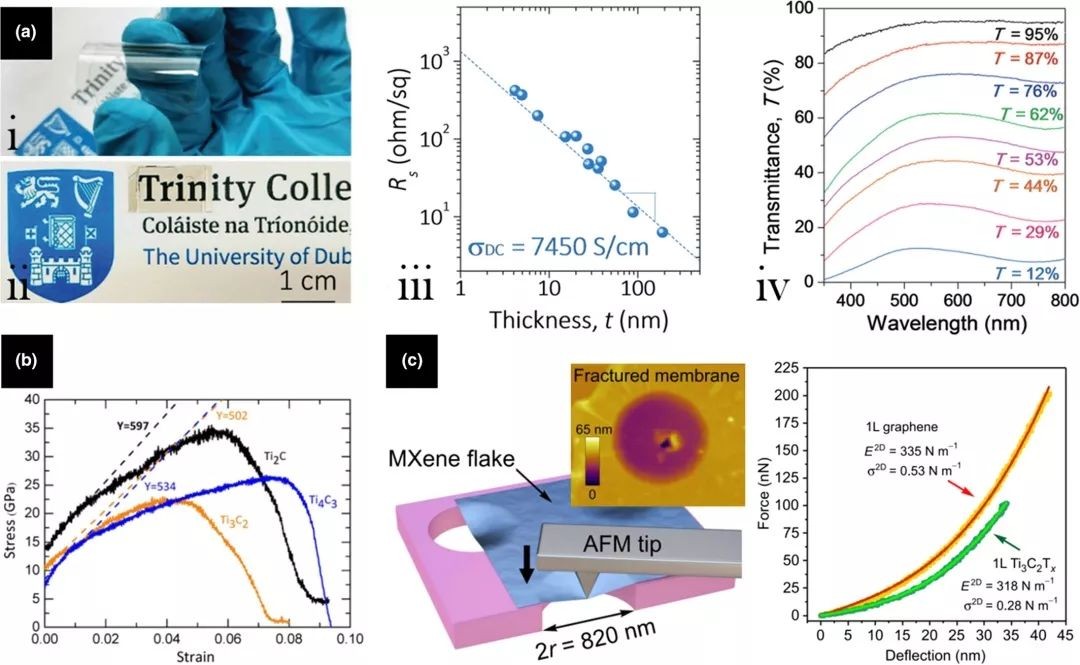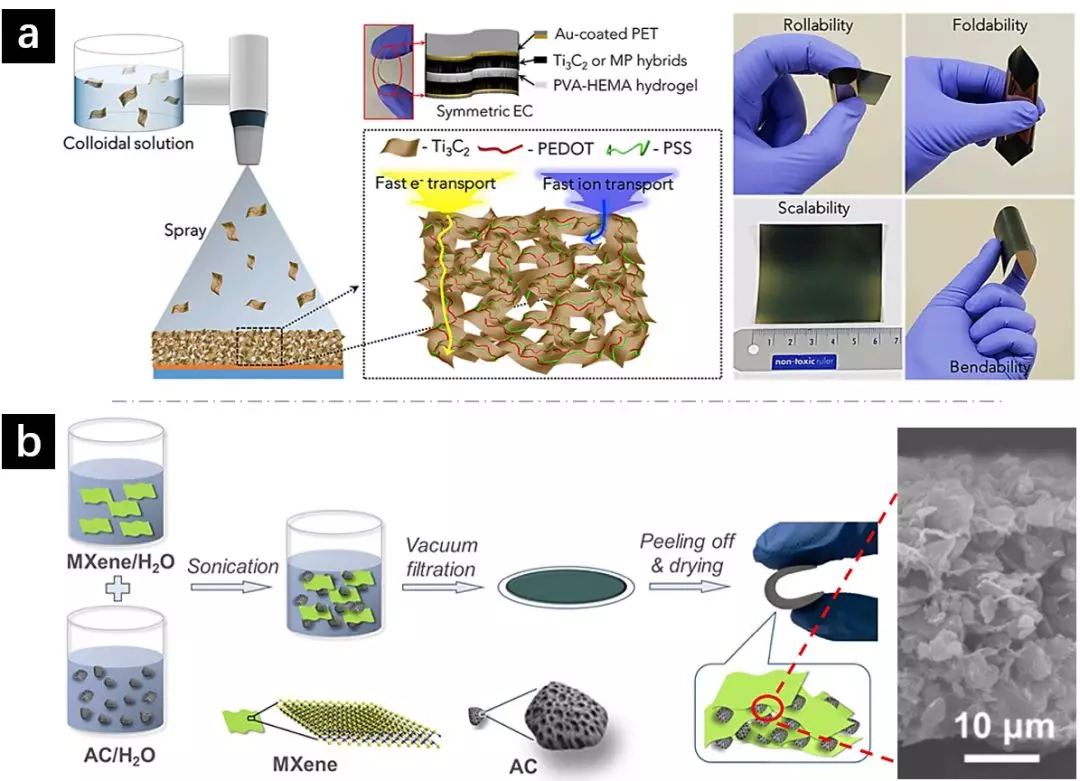Swiss Federal Institute of Technology Zhang Chuanfang EEM | Two-dimensional new favorite MXene for energy storage applications
QQ Academic Group: 1092348845
Detailed
introduction
Figure 1. Many features of MXene
Recently, Zhang Chuanfang, Institute of Materials Science, Swiss Federal Institute of Technology, published an article entitled "Two-Dimensional Transition Metal Carbides and Nitrides (MXenes): Synthesis, Properties and Electrochemical Energy Storage Applications" in Energy & Environmental Materials. This article first systematically reviewed the synthesis, intercalation, and peeling methods of MXene. The article then highlights the many properties of different MXene family members, including properties such as electrical conductivity, thermal conductivity, energy bands, optoelectronics, mechanical, and thermodynamics. Finally, the article highlights MXene‘s electrodes for supercapacitors and rechargeable batteries (including lithium, sodium, potassium, aluminum-ion, and lithium-sulfur batteries) for building high surface and volume capacities. This review sorts out the preparation, properties, and applications of MXene, helping to achieve more practical new energy storage devices.
Introduction
1. Preparation of MXene
Figure 2. (a) Element selection of the MAX precursor; (bc) Etching and morphology of MXene.
Figure 3. (ac) Application of MXene in transparent conductive films, showing electronic conductivity up to 7450 S / cm; (b) Young‘s modulus of different MXene; (c) Super mechanical strength of Ti3C2.
Figure 4. (a) Preparation of MXene-PEDOT: PSS composite flexible electrode material; (b) Preparation of MXene-AC composite flexible electrode. Utilizing the synergistic effect of the guest and MXene, not only the stacking of MXene nanosheets is effectively suppressed, but also the flexible and foldable electrode is realized using the excellent mechanical properties of MXene. These two preparation methods (mixed suspension spraying and suction filtration) are universal and can realize many MXene-based flexible composite electrodes.
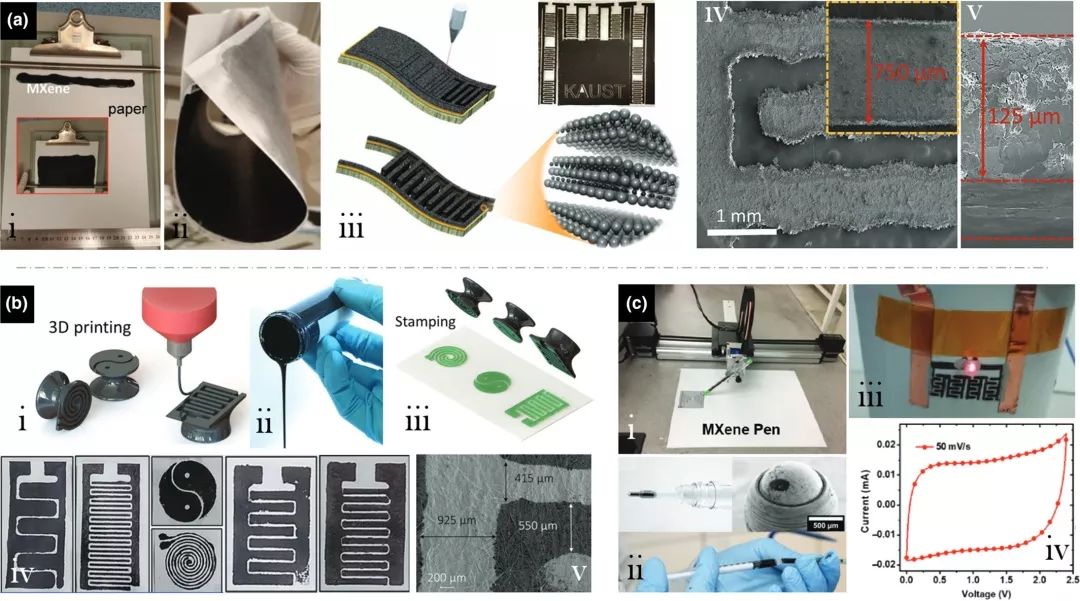
Figure 5. (a) MXene slurry coating to achieve high-capacity microcapacitor electrodes; (b) stamped MXene viscous ink to achieve high surface capacity microcapacitor devices; (c) to write microcapacitor devices.
5. Super Capacitor Device for High Volume Capacitance
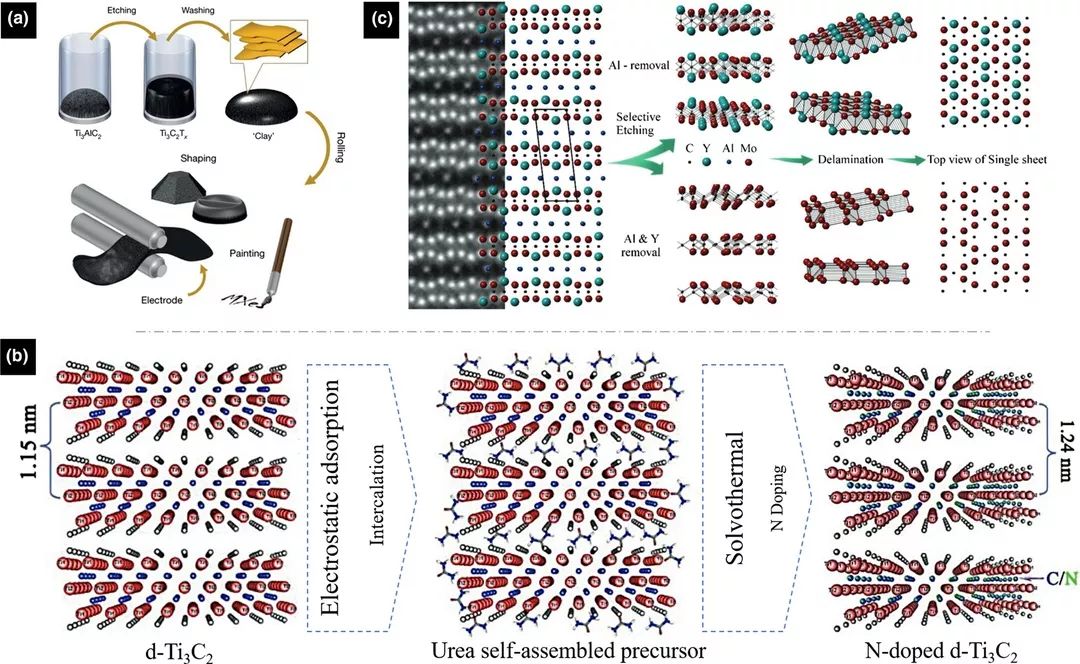
Figure 6. (a) Rolling of MXene clay to prepare a high-density, high-volume-capacity flexible electrode; (b) Introducing heteroatoms to increase volume capacity by solvothermal method; (c) Increasing electrode material density by retaining part of Al in MXene, and ultimately increasing volume capacity. Anyway. There are two ways to increase the volume capacity: increase the intrinsic weight capacity and increase the electrode density.
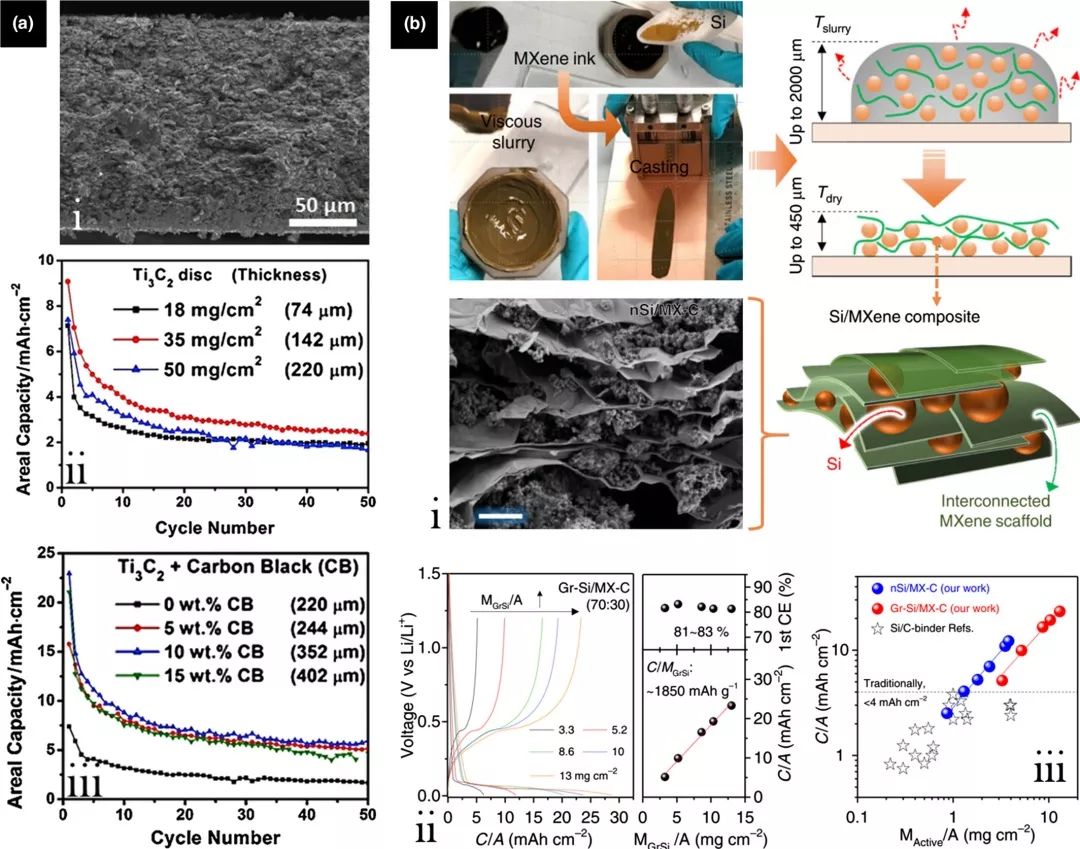
Figure 7. (a) Preparation of a high-load electrode by hot pressing with a load of up to 50 mg / cm2; (b) Direct mixing of Si powder with MXene viscous ink and coating slurry to achieve a high Si surface load Negative electrode. Si has a surface load of up to 13 mg / cm2 and a surface capacity of up to 22 mAh / cm2. These two ideas represent the classic method of realizing high-surface-capacity batteries: either desperately increase the electrode capacity, or add active materials with high theoretical capacity while increasing the capacity.

Figure 8. (ab) Increase the intrinsic capacity of the material by increasing the MXene layer spacing to achieve a high volume capacity electrode; (c) By introducing high-density active guest particles, such as cobalt oxide, and suction filtration into a dense membrane, It can achieve electrodes with a volume capacity of up to 2700 mAh / cm3, and has excellent cycle stability.
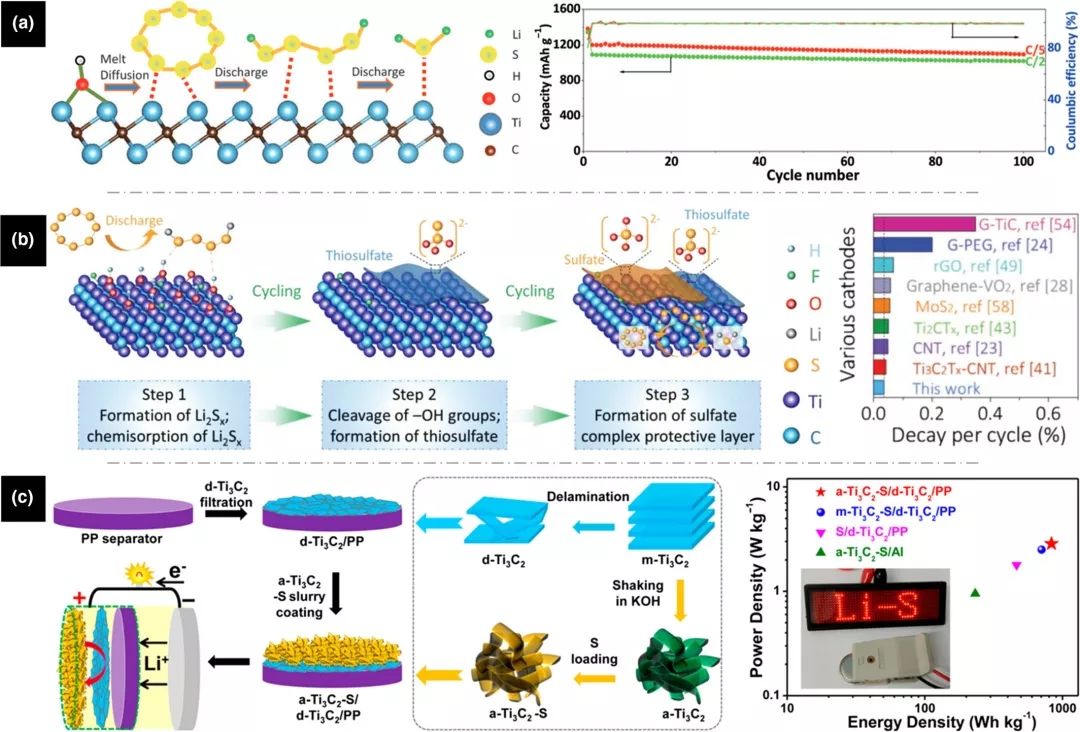
Figure 9. (ab) The key role and mechanism of MXene as a carrier of S in inhibiting polysulfide transport. The hydroxyl groups on the surface of MXene easily react with polysulfides to form thiophene sulfate, and finally form a sulfate composite protective film and effectively inhibit the penetration of polysulfides; at the same time, the exposed acidic Ti atoms can effectively catalyze polysulfides The formation of short-chain lithium sulfide promotes sulfur utilization and cycle life. (B) MXene is used as a diaphragm protective layer, which can effectively inhibit the shuttle effect of polysulfides.

Figure 10. (a) Application of different MXene flexible membranes in the negative electrode of sodium ion batteries; (b) Application of MXene in the negative electrode of aluminum ion batteries.
to sum up
At present, MXene has become a hot star material in the field of energy storage. In order to further promote the rapid development of the MXene field, the author believes that it is necessary to start around the following five aspects:
1. Find out the limitation of large-scale preparation of short plates in MAX and MXene, reduce the cost of preparation; clarify the key factors that affect the preparation process from the source, and explore new and environmentally friendly etching methods;
2. Investigate the interaction mechanism between MXene nanosheets and various solvents to improve the life of MXene suspensions in aqueous and organic solvents; strategies such as the addition of antioxidants, sheet size, defect locations and edge protection should be multi-pronged under;
3. Clarify the effect of MXene‘s surface chemistry on properties; explore the effects of interlayer spacing on outward conductivity, ion diffusion kinetics, and guest particle loading, thereby increasing the volume and area capacity of the electrode;
4. Explore device packaging technology;
5. Deepen the ability of theoretical simulation calculation and use theoretical simulation to guide the screening of more potential MAX and MXene.

Zhang Chuanfang is a senior scientist at the Federal Institute of Materials of the Swiss Federal Institute of Technology. At present, the main research fields are: printing of large-scale electronic devices based on high-quality, functional two-dimensional material ink. During his stay in the United States, he was the main researcher of the Drexel-UCLA cooperation project funded by the US Department of Energy; during his stay in Europe, he has been an ERC researcher, senior researcher, and research team leader. Invited to be a reviewer for more than 32 peer-reviewed journals, such as Nature Comm , JACS , Adv. Mater ., ACS Nano , Progress in Materials Science, etc. Published more than 50 SCI papers so far, such as Nature (Monograph Chapter), Nature Energy , Nature Communications (2), Adv. Mater (VIP), Adv. Funct. Mater (VIP), Adv. Sci , ACS Nano and other journals, among which 2 VIP papers, 2 ESI hot papers, and 11 ESI highly cited papers. H-index is 30, and is used by Science , Nature , Nature EnergySuch as SCI magazine cited more than 3400 times. Shortlisted in 2016 and 2018 Irish Young Leaders of the Year, Experimental Scientist of the Year, Experimental Researcher of the Year, Top 10 European Chinese Technology Leaders of 2019, etc.
Dr. Chuanfang Zhang‘s recent articles in the field of MXene
1. Conducting and Lithiophilic MXene / Graphene Framework for High-Capacity, Dendrite-Free Lithium-Metal Anodes, ACS Nano , 2019, https://pubs.acs.org/doi/abs/10.1021/acsnano.9b07710
2. 2D Metal Carbides and Nitrides (MXenes): Structure, Properties, and Applications ", edited by Y. Gogotsi and published by Springer Nature press, 2019. https://link.springer.com/chapter/10.1007/978-3 -030-19026-2_25
3. A Robust, Freestanding MXene-Sulfur Conductive Paper for Long Lifetime Li-S Batteries. Advanced Functional Materials, 2019, 29, 1901907. https://onlinelibrary.wiley.com/doi/full/10.1002/adfm.201901907
4. Additive-free MXene inks and their direct printing of micro-supercapacitors. Nature Communications , 2019, 10, 1795 https://www.nature.com/articles/s41467-019-09398-1
5. Ionic liquid pre-intercalated MXene films for ionogel-based flexible micro-supercapacitors with high volumetric energy density, Journal of Materials Chemistry A , 2019, 7, 9478 https://pubs.rsc.org/en/content/articlehtml/ 2019 / ta / c9ta02190f
6. High Capacity Silicon Anodes Enabled by MXene Viscous Aqueous Ink. Nature Communications , 2019, 10, 849 https://www.nature.com/articles/s41467-019-08383-y
7. In-situ Formed Protective Barrier Enabled by Sulfur @ Titanium Carbide (MXene) Ink for Achieving High-Capacity, Long Lifetime Li-S Batteries. Advanced Science , 2018, 5, 1800502 https://onlinelibrary.wiley.com/doi /full/10.1002/advs.201800502
8. Stamping of Flexible, Co-planar Micro-Supercapacitors Using MXene Inks. Advanced Functional Materials , 2018, 28, 1705506 https://onlinelibrary.wiley.com/doi/full/10.1002/adfm.201705506
9. Graphene and MXene-based transparent conductive electrodes and supercapacitors, Energy Storage Materials , 2019, 16, 102-125 https://www.sciencedirect.com/science/article/pii/S2405829718304823
10. Transparent, Flexible and Conductive 2D Titanium Carbide (MXene) Films with High Volumetric Capacitance, Advanced Materials , 2017, 29, 1702678. https://onlinelibrary.wiley.com/doi/full/10.1002/adma.201702678
11. Oxidation stability of colloidal 2D titanium carbides (MXenes), Chemistry of Materials , 2017. 29 (11), 4848-4856. Https://pubs.acs.org/doi/abs/10.1021/acs.chemmater.7b00745
12. Layered orthorhombic Nb2O5 @ Nb4C3Tx and TiO2 @ Ti3C2Tx hierarchical composites for high performance Li-ion batteries, Advanced Functional Materials , 2016, 26, 4143-4151 https://onlinelibrary.wiley.com/doi/full/10.1002/adfm. 201600682
13. Syn thesis and Charge Storage Properties of Hierarchical Niobium Pentoxide / Car bon / Niobium Carbide (MXene) Hybrid Materials. Chemistry of Materials , 2016, 28 (11), 3937–3943 https://pubs.acs.org/doi/ abs / 10.1021 / acs.chemmater.6b01244
14. Nov el solvothermal preparation and enhanced microwave absorption properties of Ti3C2Tx MXene modified by in situ coated Fe3O4 nanoparticles. Applied Surface Science , 2019, 484, 383-391. Https://www.sciencedirect.com/science/article/pii/ S0169433219308 955
15. Two-Dimensional Transition Metal Carbides and Nitrides (MXenes): Synthesis, Properties and Electrochemical Energy Storage Applications, Energy Environmental Materials , 2019, Just accepted, DOI: 10.1002 / eem2.12058.
- Previous: MXene / rGO fiber for
- Next: MXene breakthrough: Na


 mxene academic
mxene academic



